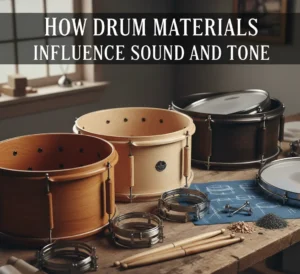Did you know drum materials actually matter? They can change the way your drum sounds. The overall tone is also affected by the material. So, choosing the right drum material matters here.
Want to know what affects the brightness of the sound? That’s the shell material you choose. The head material also impacts the pitch of the tone. For a warmer tone, wooden shells are the best. Metal shells offer more of a sharper sound.
This blog works as a guide on how drum materials influence sound and tone. Read it to understand what you didn’t know about drums.
What Are The Market And Material Trends Of Drums?
Steel drums:
These are the most used types of hazardous materials, as they are durable. These ones have structural integrity. In 2022, the steel drums market was valued at $11.78 billion. This was the global data. By 2030, it can reach $17.87 billion. The CAGR is 5.35% here.
Source: Data Bridge Market Research
Plastic drums:
These drums can retain their market presence soon. HDPE is the dominant material for 48% of the plastic drums market.
This is because of:
- Chemical Resistance
- Recyclability
Source: Data Bridge Market Research
In 2024, the market size was USD 2,121 million. By 2034, it can be USD 2,823 million. The CAGR of this growth is 2.9%.
Source: Statifacts
Fiber Drums:
In 2024, the market size was valued at USD 891.16 million. By 2032, the market may reach USD 1554.22 million. Here, the CAGR is 7.20%.
Growth is driven by demand for:
- Sustainable packaging
- Cost effectiveness
Source: Data Bridge Market Research
How Do Drum Shell Materials Affect Sound and Tone?
-
Wooden Drum Shells: Warmth and Resonance
This is the most common material for drum shells. It offers a wide variety of tonal characteristics. The sounds produced with a wooden shell are warm. The sound also resonates more with good sustain.
These factors affect how the drum resonates:
- Density
- Grain
- Porosity
Maple:
This one is known for its balanced tone. It offers a full-bodied sound with pronounced:
- Low end
- Warm mids
- Bright highs
Tone Characteristics:
- Warm
- Rich
- Balanced
- Full bodied
Birch:
Birch is more focused than the maple.
Tone characteristics:
- Bright
- Punchy
- Focused midrange
Mahogany:
Mahogany shells offer a darker tone than others.
Tone characteristics:
- Dark
- Warm
- Resonant
- Less high-end clarity
Poplar:
Poplar is a softer wood that’s less dense.
Tone characteristics:
- Balanced
- Mellow
- Less sustain
-
Metal Drum Shells: Brightness and Projection
Metal shells give a different tonal quality than others. These are made up of steel, brass, and aluminum. These drums are louder compared to wooden ones. The tones are more focused with more projection. They can also be sharper as the tone is loud. Metal shells are mostly used for snare drums.
Metal shells have these features:
- Clarity
- Brightness
- Cutting power
Steel:
Steel shells have a focused attack.
Tone characteristics:
- Bright
- Cutting
- Sharp attack
- Little sustain
Brass:
Brass shells are somewhat warmer than steel.
Tone characteristics:
- Warm
- Dynamic
- Rich
- Full-bodied sound
Aluminum:
Aluminum drums are a mix of both in terms of tone.
Tone characteristics:
- Bright
- Warm
- Resonant
- Good sustain
-
Acrylic Drum Shells: Clarity and Durability
Acrylic drums are known for their transparent look. The appearance of these shells is the highlight. A clear tone is offered with this drum material. The sound profile of acrylic drum shells is very unique. These are more focused than wood in drums. The sustain with these is long and resonant. Acrylic drums are best when you need visual impact. People also use them for a clarity of tone.
Tone characteristics
- Bright
- Clear
- Focused
- Controlled sustain
Choosing the Right Drum Material for Your Playing Style and Sound Preferences
You need the perfect match for your playing style.
Consider Your Playing Style
Are you a jazz drummer? Then you’ll want a controlled tone with less sustain. You can try out these materials:
- Maple
- Birch
Rock drummers want a more focused sound. For that, you can try out these drum materials:
- Oak
- Steel
Tuning Range and Tone Preferences
For drummers looking for a wide tuning range:
Maple shells
For drummers wanting a defined tone:
Birch
Want a punchy sound? Go for this:
- Hardwood
- Acrylic drums
Consider Durability and Maintenance
Some drummers want durability as well in the material. These materials are more durable:
- Metal
- Acrylic
Aesthetic Preferences
If you want an aesthetic look, go for these:
- Natural wood finishes
- Vibrant acrylic
- Metallic surfaces
Conclusion
Looking for the best drum material? You need to choose one that affects the sound the right way.
FAQs
Q – Where does the sound come from in drums?
A – The sound mainly comes from the drum shells.
Q – Do drums change the pitch of the sound wave?
A – Yes, drums do change the pitch of the sound wave. Pitch is as high as the sound wave frequency.
Q – What are the best materials for drums?
A – Here are the best materials for drums:
- Maple
- Mahogany
- Birch
- Oak
Q – How do drum materials affect the sound?
A – Drum shells affect the sound by impacting:
- Tone
- Volume
- Sustain





